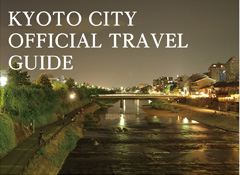【Meeting Samurai】
Course for an Immersion in History and Culture

Toei Kyoto Studio Park
Taizo-in Temple
Taizo-in Temple Ryoan-ji Temple
Start!
Randen Uzumasa Koryuji Sta.
Toei Kyoto Studio Park
-
Set in some 53,000 square meters of land, this is a Japanese movie theme park, with an open set for period dramas spreading out across enough land to fill a baseball park. Step into the studio park to instantly slip back in time to the Edo period. And, what is more, visitors can take a look behind the film-set scenes. With a major renewal in 2011, new attractions have been added, such as the Ninja Mystery House, Ukiyo-e Woodcut Print Museum and Toei Anime Museum. Although wheelchair users would find the Ninja Mystery House somewhat difficult to pass through, the Ukiyo-e Woodcut Print Museum and Toei A nime M useum c an be easily accessed by wheelchairs to enjoy the fun inside. The park surface is flat and any steps and stairs are equipped with slopes, so wheelchair access is good. Guided park tours by actual actors are available all year round and there are many events held for limited periods too, so check the schedule at the Padios attraction hall. Also, in March 2012, the Haunted House ‒ the scariest in history - was refurbished, so why not take a trip around and see if you can refrain from screaming. 
F1 toilet in Padios at Studio Park ▶See details 
Toilet near to Shuriken Dojo in Studio Park 
Toilet in Studio Market in Studio Park 
Toilet at entrance to studio in Studio Park
Uzumasa Sta.
→To Taizo-in Temple Coruse
Katabiranotsuji Sta.
→To Ninna-ji Temple Coruse

JR Line Uzumasa Sta.
-

Toilet inside (beyond tkt barrier) JR Uzumasa Stn. JR Hanazono Sta.
-

Toilet inside (beyond tkt barrier)
JR Hanazono Stn.
-
・North side of Hanazono Sta.
・Myoshin-ji Temple grounds -

South toilet in grounds of
Myoshin-ji Temple Taizo-in Temple
Ryoan-ji Temple

▶Expand photo
Established in 1404, this is an ancient leading temple in the grounds of Myoshinji. On the west side of the abbot's chambers there is the Motonobu garden, which is dry landscape g arden b uilt b y t he M uromachi-era a rtist Motonobu Kano ‒ however, viewing is not allowed. The garden is praised for looking like a painting with its evergreen trees and white sand along with dynamically arranged rocks. It is designated a national historic site and a place of scenic beauty. Also, in the abbot's chambers, a replica of the Indian ink painting "Hyonenzu" depicting a catfish and a person holding a gourd (national treasure) is displayed. The "nen" part of the title from the Chinese character for catfish. The person in the picture is trying to capture a slippery catfish with a smooth gourd, and the conundrum of this paradox was used as a Zen riddle. Thus, such futile actions came to be k nown by the expression "hyotan-namazu" (gourd-catfish). From here the Yokoen garden (designed by the famed twentieth century landscape gardener Kinsaku Nakane) spreads out as a strolling garden. Each season has its charm in this exquisite garden that also offers the sounds of suikinkutsu and waterfalls. This truly is a place to dwell and listen.

▶Expand photo
In 1450, the Tokudaiji family villa came into the possession of Katsumoto Hosokawa, who established this temple on the villa site. Now registered as a World Heritage Site, Ryoan-ji Temple is acclaimed for its dry landscape garden (both a Special Historic Site and a Special Place of Scenic Beauty), with its simple design of white gravel and 15 rocks that mesmerize visitors into prolonged meditation as they admire the simplicity of its beauty. Also, on the northeast side of the abbot's chambers, there is a tsukubai, or water basin, with a square hole surrounded by four Chinese characters, or kanji, that strangely look like legs coming out of the central square mouth, but, in actual fact, can be read as a Zen maxim: "wareta-datare-wo-shiru". In the shop in the priests' living quarters there are bottle opens and protective charms in the shape of this tsukubai basin, which make great gifts.
Goal!

Keifuku Kitano Line Katabiranotsuji Sta.
Keifuku Kitano Line omuro ninnaji sta.
Omuro Ninna-ji Temple

▶Expand photo
oted as a cherry blossom spot, this is the head temple of the Omuro School of the Shingon sect. Emperor Koukou started construction of the temple and his successor Emperor Uda completed it in 888. When Emperor Uda retired from the throne, he became head priest at the Ninna-ji Temple. From then on, a succession of Imperial princes took up temple life, leading to the name "omuro gosho" (a reference to the palatial trappings of the temple) being applied to the temple. Set in some 90,000 square meters of grounds, the temple is dotted with halls that are national treasures and important cultural assets. In the southwest section of the grounds there is a magnificent garden and building (Goten).
・Kinukake no michi
Ryoan-ji Temple

▶Expand photo
In 1450, the Tokudaiji family villa came into the possession of Katsumoto Hosokawa, who established this temple on the villa site. Now registered as a World Heritage Site, Ryoan-ji Temple is acclaimed for its dry landscape garden (both a Special Historic Site and a Special Place of Scenic Beauty), with its simple design of white gravel and 15 rocks that mesmerize visitors into prolonged meditation as they admire the simplicity of its beauty. Also, on the northeast side of the abbot's chambers, there is a tsukubai, or water basin, with a square hole surrounded by four Chinese characters, or kanji, that strangely look like legs coming out of the central square mouth, but, in actual fact, can be read as a Zen maxim: "wareta-datare-wo-shiru". In the shop in the priests' living quarters there are bottle opens and protective charms in the shape of this tsukubai basin, which make great gifts.













